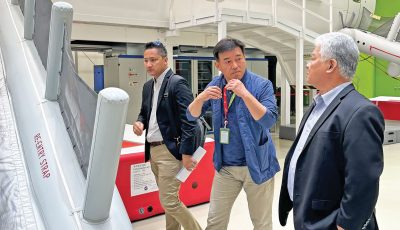Vigan, Laoag escapades in 24 hours

Travel back in time as you walk the historic town of Vigan’s cobblestone streets or while riding a horse-drawn carriage (calesa), clip-clopping through ancestral houses that form part of the second greatest architectural legacy of the Spaniards in the Philippines after the walled city of Intramuros in Manila.
The difference is that in Vigan, many of the old houses still stand, becoming living museums of a spirited past. One can almost sense history in every corner, fascinating in every aspect.
Established in the 16th century, Vigan is the best preserved example of a planned Spanish colonial town in Asia and was inscribed in UNESCO’s World Heritage List in 1999.
To this day, no other town in the Philippines evokes old-world allure better than Vigan with its architecture that blends elements from elsewhere in the Philippines, China, and Europe. Vigan is in the province of Ilocos Sur in northern Luzon.
Visiting Vigan’s heritage village was among the highlights of a 24-hour Ilocandia escapade I spent with my mother, sister, and cousins while on a 10-day vacation months ago.
My mother, a native Ilocana from Isabela (the country’s second largest province next to Palawan), said that stepping foot on Vigan was much more fun and awe-inspiring than just seeing it on TV or reading about it in travel magazines.
We rented two calesas that took us on a tour of cobblestoned streets past ancestral houses, merchants, and residents, a scene reminiscent of the 16th century.
“Road trips. It’s More Fun in the Philippines,” goes the country’s now world-renowned tourism slogan. Road trips using calesa is indeed much more fun than using a car to get you from point A to B. These horse-drawn carriages were the mode of transportation in olden times and even up to these days in certain parts of the country.
Vigan’s ancestral homes, some of which were transformed into museums, bear “ancient tiled roofs, massive hardwood floorings, balustrades and azoteas in varying Spanish-Mexican-Chinese architectural styles,” although some houses now need delicate care.
The ground floors of many of these houses were converted into cafes, restaurants, shops for souvenirs, wooden furniture, antiques and authentic Ilocano weaving in different kinds of “Abel” cloth.
Among those we visited was the Syquia Mansion on Quirino Boulevard, now a museum filled with exquisite centuries-old furniture and exhibits dedicated to the life of Vigan native Elpidio Quirino, the Philippines’ sixth president. Quirino is best remembered as the chief architect of the economic development the country undertook to rise from World War II’s devastation.
Quirino, born in the nearby provincial jail where his mother worked, rose to political prominence after marrying into the wealthy Syquia family. Thus the Syquia Mansion housing Qurino’s extensive memorabilia is actually owned by his wife, Doña Alicia Quirino. Her ancestor was a Chinese man who made his fortune in trade in Vigan. What was “Sy Kia” became a hispanized “Syquia” later on. Visitors to the Syquia Mansion can view a portrait of “Sy Kia” with his braided long hair and traditional Chinese robes.
The Syquia Mansion, just like the other houses we visited in Vigan, offers an insight into how people lived back in the colonial era. The tour was a charming blast from the past. A caretaker of the Syquia family was always around to accompany visitors. He gave us important and intriguing details.
It was where our “all girls” group got a picture of the term “aliping sagigilid,” derived from that extra space-about an arm’s length-between grand rooms and exterior walls where house helpers during colonial times could go from one room to the other without being seen by visitors.
Do not pass up the chance to look through the peepholes found in the master’s bedroom and the second floor. These peepholes were used to view visitors in the receiving area before they are allowed to enter the grand living room. The Syquia Mansion tour is free, but donations are welcome.
Lunch was at Grandpa’s Inn, also a Spanish ancestral home converted into a cozy hotel with a rustic ambiance and hearty food.
Take a stroll at the Plaza Salcedo where the provincial capitol is located, along with St. Paul’s Cathedral and El Arzobispado de Nueva Segovia. Also check out the Crisologo Museum, Café Leonora, and Padre José Burgos National Museum.
Remember Demi Moore’s pottery scene in the movie Ghost? You can be your own Demi Moore, or even Patrick Swayze, in any of the potteries in a village called “Pagburnayan,” which literally means “place where ‘burnay’ is made.” “Burnay” is an earthenware jar crafted by a potter’s hands with the aid of a potter’s wheel.
Here, the pottery process uses fine sand as a tempering material and fired at high temperatures in a huge brick-and-clay ground kiln, making it harder and more durable than other terra cotta.
“Baluarte ni Chavit Singson,” owned by Ilocos Sur governor Luis “Chavit” Singson, was another stop that day. There is no entrance fee to this sprawling 80-hectare expanse of boulders and mountain sides amidst trees and greens, serving as an interactive sanctuary for Singson’s personal collection of wild animals like tigers, camels, ostriches, snakes, donkeys, stags, pheasants, parrots, and macaws, among other things.
You can pet and feed most of the animals. You can also get to ride small horses that will tour you around the zoo. Life-size dinosaur statues make for interesting backdrops for souvenir photos.
Ilocos Sur is also the birthplace of national heroes, including Diego Silang and his brave wife Gabriela Silang, and Padre Jose Burgos of the famed GomBurZa.
If you have more than 24 hours to spare, other interesting stops in Ilocos Sur should include the centuries-old Sta. Maria Church, a National Landmark, which was used as a fortress during the Philippine Revolution of 1896; Tirad Pass, declared a National Shrine, that had been the last stand of the Filipino Revolutionary Forces under Gen. Emilio Aguinaldo during the same period; and Bessang Pass, which served as the backdoor to General Yamashita’s last-ditch defense during the final stage of World War II.
A packed one-day, one-night Ilocandia escapade isn’t complete without sampling Ilocano cuisine-the legendary pinakbet, dinengdeng, Ilocos empanada, Ilocos longganisa, among other gastronomical delights-but more on this in the second part of this series.
To be concluded.
By Haidee V. Eugenio
Reporter



























